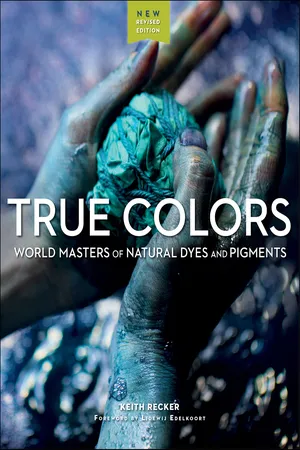
This is a test
- 252 pages
- English
- ePUB (mobile friendly)
- Only available on web
eBook - ePub
Book details
Table of contents
Citations
About This Book
This updated 2nd edition features a revised chapter. True Colors is about artists who create color from natural materials and about the historical importance and environmental sustainability of this practice. Deep conversations with 26 artisans from every part of the globe reveal their wisdom, traditions, and know-how—and suggest that we ignore what they know at our peril. Traditional approaches to making color offer sustainable options to a fashion system badly in need of them and memorable cultural narratives to a world hungry for beauty and spirituality. True Colors provides an immersive visual experience and an inspiring travelogue of personal stories and practical information from artists who are leaving their mark on the world.
Frequently asked questions
At the moment all of our mobile-responsive ePub books are available to download via the app. Most of our PDFs are also available to download and we're working on making the final remaining ones downloadable now. Learn more here.
Both plans give you full access to the library and all of Perlego’s features. The only differences are the price and subscription period: With the annual plan you’ll save around 30% compared to 12 months on the monthly plan.
We are an online textbook subscription service, where you can get access to an entire online library for less than the price of a single book per month. With over 1 million books across 1000+ topics, we’ve got you covered! Learn more here.
Look out for the read-aloud symbol on your next book to see if you can listen to it. The read-aloud tool reads text aloud for you, highlighting the text as it is being read. You can pause it, speed it up and slow it down. Learn more here.
Yes, you can access True Colors by Keith Recker in PDF and/or ePUB format, as well as other popular books in Economics & Sustainable Development. We have over one million books available in our catalogue for you to explore.
Information
Table of contents
- Cover
- Title Page
- Copyright
- Acknowledgments
- Foreword
- Table of Contents
- Engaging with Color: An Introduction
- Chapter 1: A Point of Silence - Birgitta de Vos creates space for contemplation
- Chapter 2: Tradition and Progress - Boubacar Doumbia uses mud cloth to create employment for young people
- Chapter 3: A Piece of Sky - Heartwear is an alliance between Parisian designers and Yoruba indigo makers of Cotonou, Benin
- Chapter 4: Wandering Into the Blue - Han Shan rejected life in industrialized China to create blue the way his Miao foremothers taught him
- Chapter 5: Blue Revival - Guided by fair-minded principles, the revival of indigo production in Bangladesh counters bitter memories of repressive colonial-era practices
- Chapter 6: Indigo Genie - Indigo and porcelain explored by this mother-and-son team Deborah and Lucas Osburn
- Chapter 7: Layer Upon Layer - Artist Mary Hark dyes her handmade papers with African indigo
- Chapter 8: Nevertheless Woad Persisted - Dyer, weaver, and teacher Aviva Leigh works extensively with Europe’s earliest blue dye
- Chapter 9: The Last Purple - The ancient sea-snail purple of Mexico’s coastal Mixtec dyers and weavers is severely endangered. Tixinda holds the future.
- Chapter 10: Serious Symbols - Logwood resurfaces in the 21st century in the sustainability-conscious designs of Buro Belén
- Chapter 11: Authentic Voices - In keeping with Zapotec tradition, Juana Gutiérrez Contreras and Porfirio Gutiérrez employ ancient cochineal and other natural dyestuffs in their weaving
- Chapter 12: Bukhara Red - Master dyer, teacher, and weaver Fatillo Kendjaev works with millennia-old madder reds in modern times
- Chapter 13: Red Rises Again - The Institute of Khmer Traditional Textiles helps save the lac reds of Cambodian ikat in the post-Khmer Rouge era
- Chapter 14: In the Water - María Elena Pombo explores the pinks of avocado pit dyes, and the color variations created by water sources around the world
- Chapter 15: Stalking Wild Color - Mycologist turned natural dyer, Alissa Allen knows how to extract gorgeous (and responsible) color from fungi
- Chapter 16: Old Ways, New Techniques - Australian artist India Flint draws brilliant patterns with just eucalyptus leaves, and water, and a little science
- Chapter 17: In the Beginning - Like our most ancient ancestors, Heidi Gustafson is a connoisseur of earth pigments
- Chapter 18: Precontact Colors - Can the Ayoreo of Bolivia keep their ancient dyeing and weaving techniques alive? Cheque Oitedie is working for that to happen.
- Chapter 19: Earthy Rainbow - Navajo dyer and weaver Irene Clark harvests rich colors from gray lichens and other natural dye plants
- Chapter 20: Like a Prayer - Rupa Trivedi extracts vivid yellows from the marigold petals left as offerings at Mumbai’s renowned Siddhivinayak Temple
- Chapter 21: Golden Girls - Audrey Louise Reynolds challenges fashion orthodoxy with turmeric and other natural dyes
- Chapter 22: Precise Yellows - Dyer, weaver, and artist Catherine Ellis embraces exactitude with weld and other garden-grown natural dyestuffs
- Chapter 23: Invasive Color - The Avani organization turns an invasive weed called “forest killer” into beautiful, non-toxic yellow and green dyes, crayons, and watercolors
- Chapter 24: Fresh Greens - Nilda Callañaupa Alvarez and the Center for Traditional Textiles of Cusco extract rare natural greens from two local plants
- Chapter 25: Mineral Signatures - Atelier NL turns sand collected from beaches all over the world into place-specific greens
- Chapter 26: Back to the Garden - Sasha Duerr deepens her students’ attachment to the environment by using “natural color as a gateway drug”
- Notes
- Bibliography
- Index
- Photography Credits